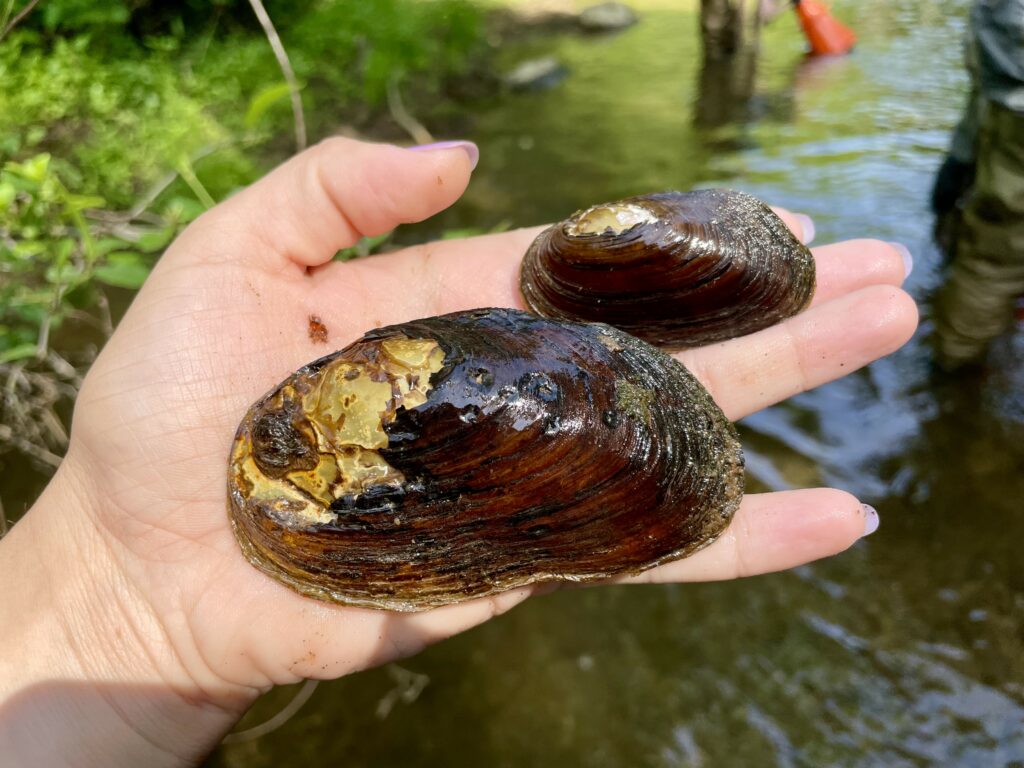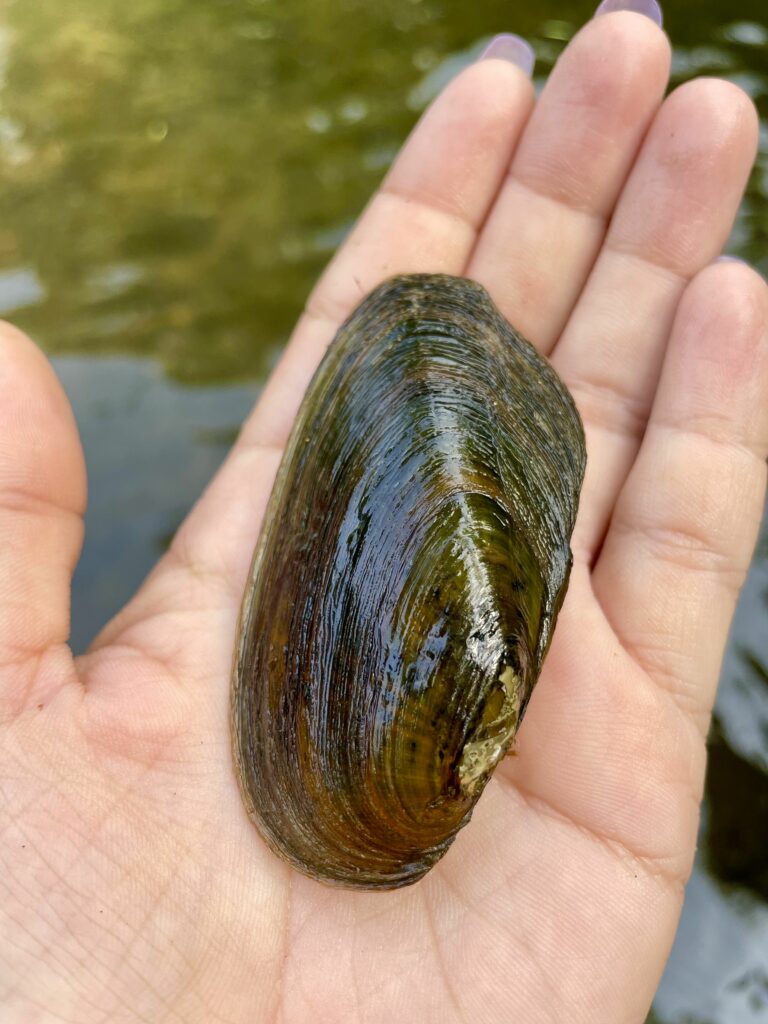By Watershed Protection Program Co-Op Sarah Busby
Within our streams, there are many players that work to create a functioning, thriving ecosystem. From the tall trees that hang overhead at the bank’s edge, providing cooling shade and abundant habitat, to charismatic animals like the beaver that literally shape the movement of the stream, some species play a more visible role than others. However, there are plenty more individuals hard at work behind the scenes, — or rather, below the surface of the stream. One such character is the freshwater mussel. Sometimes mistaken for a stone, this unassuming animal quietly resides at the bottom of our streams, often going unnoticed. While an individual mussel may be overlooked, their dramatic impact on a stream is impossible to miss when they work together.

Freshwater mussels begin their life in a curious fashion, highly dependent on the fish in their communities. During reproduction, female mussels release packets of larval mussels, or glochidia, carefully timed with the encounter of a suitable host fish. After release, the larval mussels must attach to the gills of their host to survive. Once the larvae have secured a ride, they will travel with their host until they grow big enough to go off on their own, which may take up to a few weeks. When ready to depart, the mussels drop off and settle down into the riverbed. Host fish not only provide a safe haven for the larval mussels to develop in, but also allow for them to disperse much greater distances than freshwater mussels could ever go on their own. While glochidia do not cause harm to their host in most cases, the obligate parasite owes much to the hosts they grow up in. Though freshwater mussels are quick to give back to their neighbors once they come into adulthood.
Freshwater mussels are constantly filtering through water to breathe and feed. Typically, they sit partially buried into the substrate, siphoning in water. As water flows through their gills, they filter out bacteria, algae, phytoplankton, detritus, and other small organic particles to feed on. In this process, they also filter out pollutants from the water, accumulating the contaminants into their own bodies.
The filter-feeding activities of mussel populations greatly improves the water quality of the bodies of water they inhabit. This is beneficial to the rest of their local community. The fecal pellets they expel provide food for other invertebrates, and the mussels themselves are consumed by fish, birds, and mammals alike. Additionally, their shells provide shelter and habitat for aquatic invertebrates like caddisflies, midges, and other insects that fish rely on for sources of food. Much like the fish who sheltered them in their vulnerable state, an adult mussel provides for its community throughout its entire lifetime of up to a century, and even beyond when only its shell remains.

Freshwater mussels have a long history of providing not only for their aquatic communities, but for humans as well. These mussels were a major food source for many prehistoric [1] and pre-colonial people in North America. Multiple Native American tribes have mussel harvests that date back to over 10,000 years ago. The shells were used for creating tools and jewelry. Before the invention of plastic, buttons were also made from the shells of mussels. The mentioned uses were in addition to the ecological service mussels provide by improving the quality of our water sources. While the cultural use of mussels has shifted over time, this critical service upholds its relevance.
Now in modern times, freshwater mussels are more vulnerable than ever before. From habitat degradation, pollution and impaired water quality, mussels face threats on multiple fronts — many of which are human imposed. As many native host fish species decline, the mussels follow close behind.
Currently, freshwater mussels are considered the most endangered group of organisms in [2] the country. It is our turn to provide for the mussels and the communities that come with them. Protecting the mussels means protecting our rivers and streams. Current efforts are being made to reintroduce [3] freshwater mussels into our streams and foster their growth through research and restoration. But success of these efforts is brought to fruition through community support. It starts with appreciating the role mussels play in a thriving ecosystem and follows by embracing our own part in it.[4]
— By Watershed Protection Program Co-Op Sarah Busby
Sources:
About freshwater mussels. Pacific Northwest Native Freshwater Mussel Workgroup. (n.d.). Retrieved June 6, 2022, from https://pnwmussels.org/about-freshwater-mussels/
Freshwater Mussels. Center for Biological Diversity. (n.d.). Retrieved June 6, 2022, from https://www.biologicaldiversity.org/campaigns/freshwater_mussels/
Freshwater mussels. Partnership for the Delaware Estuary. (2020, July 17). Retrieved June 6, 2022, from https://delawareestuary.org/science-and-research/freshwater-mussels/
Jaramillo, C. (2018, May 2). With nation’s first city-owned Mussel Hatchery, Philly employing bivalves in battle to improve water quality. WHYY. Retrieved June 6, 2022, from https://whyy.org/articles/with-nations-first-city-owned-mussel-hatchery-philly-employing-bivalves-in-battle-to-improve-water-quality/
Mussels and Us Prehistory. FMCS – Freshwater Mussels. (n.d.). Retrieved June 6, 2022, from https://molluskconservation.org/MUSSELS/Prehistory.html
Strayer, D. L. (2017). What are freshwater mussels worth? Freshwater Mollusk Biology and Conservation, 20(2), 103–113. https://doi.org/10.31931/fmbc.v20i2.2017.103-113
Wimberly, B. (2021, August 26). The “mussel” Behind the delaware river watershed’s clean water. Audubon Pennsylvania. Retrieved June 6, 2022, from https://pa.audubon.org/news/%E2%80%9Cmussel%E2%80%9D-behind-delaware-river-watershed%E2%80%99s-clean-water

